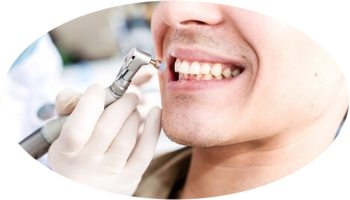What is Scaling and Polishing or Teeth Cleaning?
Our mouth is the gateway to all the things that go into our bodies. It is a window that provides essential functions to keep us alive for example eating, drinking, etc. On the other hand, our mouth is a hub of various species of bacteria that live, grow and multiply every second. Some of these are good for our health, however; most of them affect the mouth and body negatively. That is why it is essential to keep good oral hygiene, including brushing and flossing. Often brushing and flossing alone cannot completely remove the bacteria and food debris from the hard-to-reach area (between the teeth, gum margins, gum lines, or below gum lines) in the mouth.
These bacteria and food remnants if left uncleaned, produces plaque. This plaque is soft in nature and can be visible as whitish-yellow or light brown on the teeth, on the gum lines, and between the teeth. Note that this plaque can be easily cleaned and removed using the correct methods of brushing and flossing. However, this plaque can grow and mature into a hard and tenacious substance known as calculus or tartar if left uncleaned. The tartar is tenacious and cannot be removed using a toothbrush or floss. This can then be removed professionally by a skilled dentist or dental hygienist.
What is scaling and polishing?
Scaling is a professional method of removing tartar using hand and power-driven instruments. It is a non-surgical procedure that meticulously removes the tartar buildup and flushes the bacteria out. In addition to the tartar and bacteria, scaling also effectively removes the superficial stains (present on the enamel surface). On the other hand, polishing is also a non-surgical procedure that is recommended after the scaling. It removes the remaining stains after the scaling, smoothens the teeth surface, and brings out the natural color of the teeth.
Why scaling and polishing?
Plaque and tartar induce inflammation in the gums leading to bleeding at initial stages and destruction of the tooth-supporting structures at later or severe stages. It saves our gums and teeth from developing gingivitis (the initial stage of gum disease) and periodontitis (a severe form of gum disease). Moreover, periodontal disease will lead to tooth mobility and tooth loss if left untreated. Besides, plaque and tartar accumulation will produce bad breath and dental cavities.
Procedure
Our dentists or dental hygienist will first make sure to perform a thorough clinical and radio graphical examination. Based on the clinical and radio graphical examinations, a treatment and care plan is devised. If you have not had a dental cleaning in a long time, your gums may be sensitive. If this is the case, an anesthetic gel or local anesthesia is used to make your procedure more comfortable.
Hand and power-driven instruments such as scalers and ultrasonic can also be used to remove the plaque and tartar from the gums and beneath the gums as well. It might take an hour or multiple visits for a dental cleaning; mostly it depends on the amount of tartar build-up.
Sometimes, local anesthesia (a numbing agent) is used to numb the treatment site. This is usually the case when a patient feels pain or the tartar is heave and deep into the gum pockets.
Once the treatment is completed either in a single or more than one visit, it is followed by polishing. Polishing is done at the last visit.
Post-procedure, mild soreness can be sensed, and it will relieve after few days. Over-the-counter medications can be used in case of severe pain, or consult your dentist or dental hygienist.




